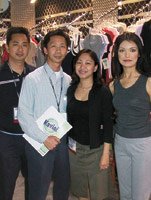Rising Cotton Prices Don't Hinder Exhibitors at ISS
Despite concerns over rising cotton prices, garment and technology suppliers exhibiting at the Imprinted Sportswear Show, held Jan. 16–18 at the Long Beach Convention Center in Long Beach, Calif., were optimistic about business going forward. Steady attendance, improved economic indicators and new products have helped to fuel the momentum.
“It’s been a good show—we’re hearing mostly positive comments,” said Jim Gordon of Anaheim, Calif.–based Alstyle Apparel Ltd., a supplier of blank shirts and fleece. “This show usually is a good barometer of the year to come, and everyone’s optimistic, so that’s a start.”
With 12,300 visiting the show, turnout was on par with last year’s attendance, said Art Ellis, group vice president, apparel, for show producer VNU Expos of Roswell, Ga.
“The buzz was good,” Ellis said. “People were buying this year. You didn’t have as many tire kickers. I think it has to do with an improving economy.”
Because most exhibitors and attendees at ISS deal in cotton goods such as T-shirts and fleece, the spike in cotton prices during the past year had them talking about raising prices. Cotton prices rose at least 30 percent in 2003 because of fluctuating weather patterns in cotton-producing countries and changes in world trade regulations.
Most garment suppliers exhibiting at ISS said they were exploring ways to avoid carrying over all the increases to their customers. Yet, most concurred that price hikes are imminent.
“We signed [long-term] contracts with the big yarn houses to avoid these situations,” said Dean Vuong, vice president of Commerce, Calif.–based Kavio!, which supplies juniors and children’s tops to private-label clients.
Jim Everett, zone director for Winston- Salem, N.C.–based Hanes Printables Inc., a division of the Sara Lee Corp., said the increases could actually help the industry. He noted T-shirt prices have been depressed for several years. “Nobody’s going to make a lot of money when you’re selling T-shirts for 79 cents a piece,” he said.
While fabric costs will remain an issue this year, resources at ISS also focused on standing out from the competition with incentive programs and product innovations.
“The market is focused on price right now,” Everett said. “We’re trying to differentiate. We don’t want to be a ’me too’ company. We have to sell more than just price.”
Hanes showed 23 new products and features, ranging from new tagless labeled shirts to fitted sweat pants with ankle zippers to stain-repellent work clothes.
“People are getting smarter. They’re getting into niches and becoming more creative,” added Jan Springer, owner of Commerce, Calif.–based Jantex Inks and Beyond Inc., which supplies Mimaki inkjet printers to textile companies.
Some—including American Apparel, Kavio! and Active Apparel Inc.—focused on new products for the ever-changing juniors market. Los Angeles–based American Apparel showed new jersey hoodies, bra camis and pullovers. Kavio! revived the “Dolfin” shorts of the ’70s.
Santa Ana, Calif.–based Active Apparel promoted in-stock and quickdelivery programs. “We’re getting customers with fast turnarounds and prices,” said principal Wasif Siddique, who noted the company has grown from $2 million to $15 million over the past three years.
Among the advances in equipment were new label-transfer presses by Cerritos, Calif.–based Insta Graphic Systems, which allow users to apply “tagless” labels by imprinting size and wash instructions onto the garment rather than on a label. “It’s been phenomenal,” said Cris Saunders, director of sales and marketing for Insta Graphics.
Mt. Pleasant, S.C.–based Sawgrass Technologies showed a digital transfer system that uses a specialized copy machine to produce four-color transfers for garments. Computerized embroidery equipment suppliers, including Fort Worth, Texas–based Mesa/SWF, rolled out features such as upgraded holding systems, needle plates and drive rollers to facilitate the stitching process.
Springer of Jantex showed the latest in inkjet printers, which have become popular with textile companies for sample production.
“Every year, they’re getting faster and more versatile,” Springer said. “It’s only going to advance.”
























